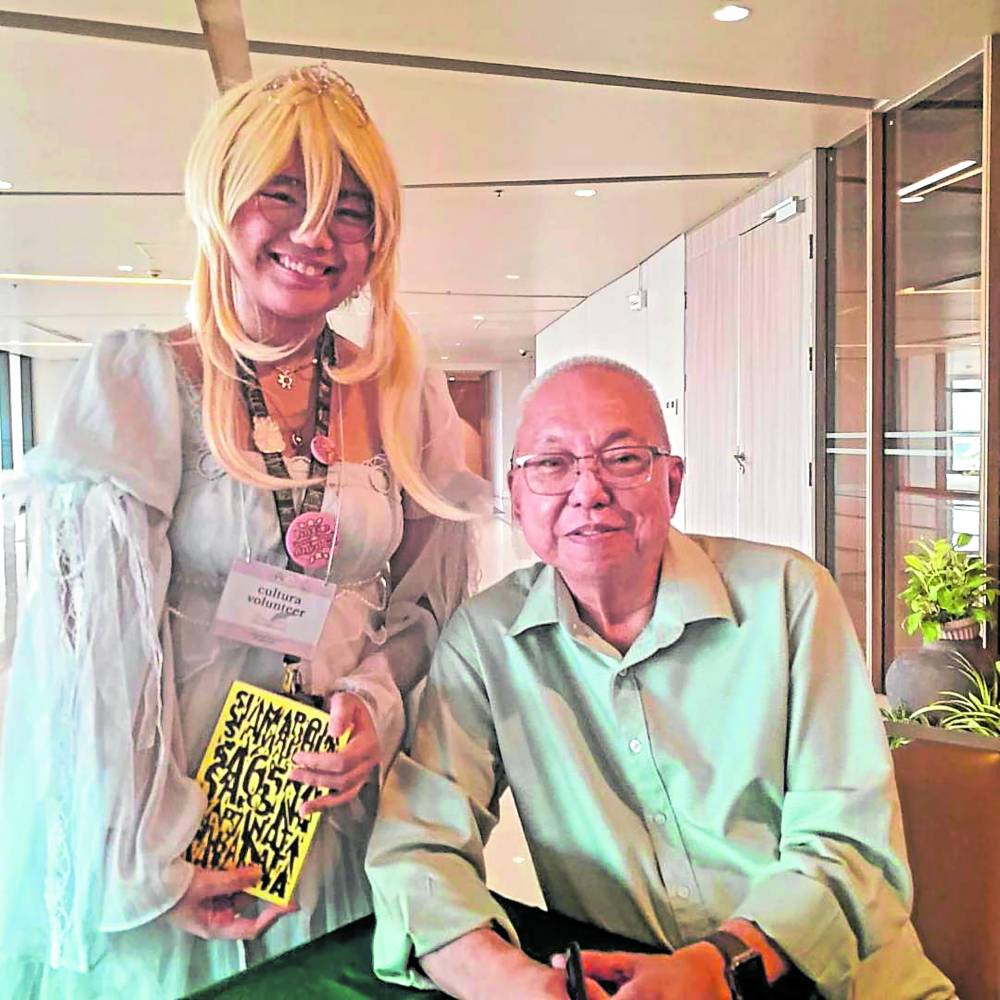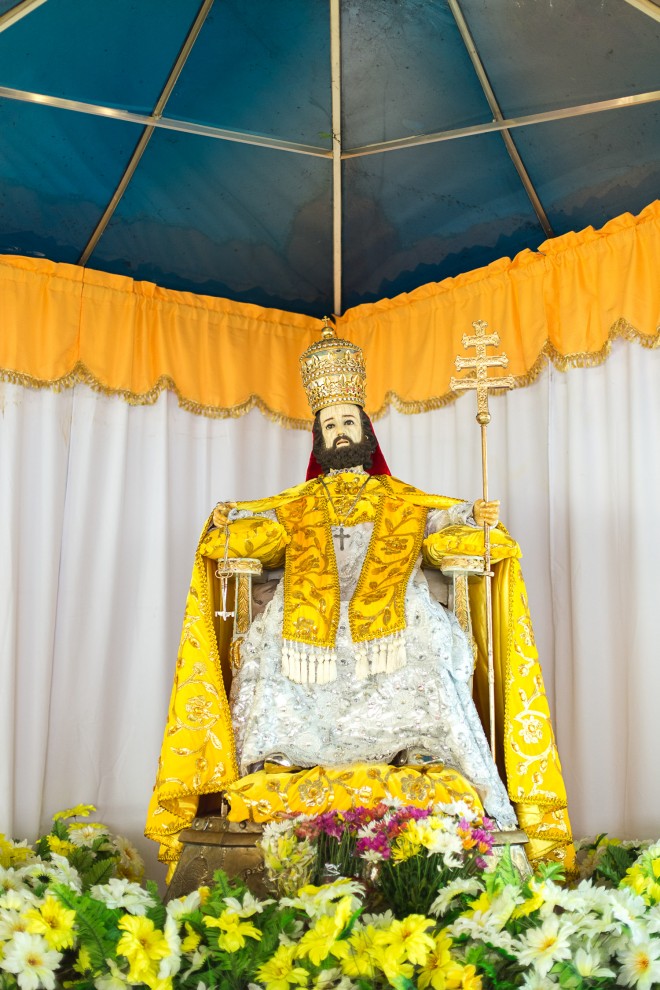
the patron saint that is feared
by the town folk, a cult derived from a macho culture
PHOTO / JILSON SECKLER TIU
In July 2002, while the good townsfolk of Barrio Capalangan in Apalit, Pampanga, lay sound asleep in their beds in the predawn chill, the Espiritu ancestral house—a stately bahay na bato said to date back to the 1840s—suddenly burst into flames.
Made mostly of wood, the house was soon engulfed. In minutes, the fire had spread to the adjoining chapel which housed Apalit’s most treasured possession: the more than 200-year-old image of St. Peter known as Apung Iru—the town’s patron saint.
Had it not been for four locals staggering home from an all-night drinking spree and who happened upon the blaze, Apung Iru would have been reduced to cinders. The four men rushed into the chapel just in time to rescue the holy image.
By morning, nothing was left of the house or chapel save for the stone azotea. Faulty electrical wiring caused the fire.
But at least Apung Iru was safe, and another miracle was added to the long list of supernatural occurrences attributed to the image.
16th century
The cult of Apung Iru remains alive in Apalit, best known to history buffs as the home of the legendary 16th-century cannon-maker, Panday Pira.
Every year, on the last three days of June, residents celebrate the fiesta of Apung Iru with Masses, processions, a fluvial parade and—this being Pampanga—lots of food and drink.
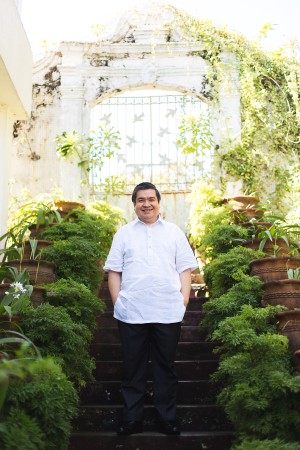
“The fiesta in the Spanish sense is very much alive in Apalit, I would say more than in a lot of Filipino towns,” says Augusto “Toto” Gonzalez III.
Best known for his popular high society blog “Remembrance of Things Awry,” Gonzalez is Apung Iru’s current camarero or custodian, a hereditary position handed down from generation to generation by the family “owning” the image.
Feudal remnant
A remnant of the feudal era, the practice of giving custody of a town’s patron saint to a prominent family was established by the Spanish friars, mainly so they wouldn’t have to spend for its upkeep and for the annual fiesta celebration.
It was a position of some prestige, much coveted by the landed gentry of Apalit.
Gonzalez’s ancestor, Pedro Armayan-Espiritu y Macam, acquired the position in the early 1800s, in exchange for a considerable parcel of land, and it has been in the family since.
The image itself once came with an inheritance of 45 hectares of farmland to pay for its upkeep, says Gonzalez.
But sainthood, it seems, didn’t exempt Apung Iru from land reform. Now Gonzalez has to pay for the saint’s board and lodging, and the annual fiesta celebration, out of his own pocket. He considers it a family obligation.
St. Peter is more commonly depicted as Peter the apostle, carrying a cock to remind him of his shame.
But Apung Iru is flash in a typically Capampangan way. He is depicted as the first pope: sitting regally on a throne, wearing a silver miter and shoes, and holding the papal staff.
The image’s face and hands are carved from ivory, and his vestments are covered with elaborate embroidery and beadwork.

Macho devotion
Like the Black Nazarene of Quiapo, Apung Iru inspires devotion, mostly among the Apalit menfolk.
“It’s a very testosterone-laden, macho devotion,” says Gonzalez. “The townspeople revere and love him so much that they feel they have to carry him in an andas, which is basically a caro (carriage) without wheels.
“A lot of these patron saints were put up by the Spaniards to replace the anitos in the 1550s,” he adds. “I’ve always wondered if there might have been a river deity in Apalit that the natives worshipped, and which just morphed into Apung Iru.”
Among Apalit natives, he says, Apung Iru is thought of as a temperamental saint who needs to be appeased by ritual, mainly the rigorous observation of his feast day.
“There is so much fear attributed to the image,” says Gonzalez. “People say ‘Magagalit si Apung Iru’ if we scrimp on the fiesta.”
But Apung Iru is also a divine fixer who can grant boons to those who pray to him. People leaving to work abroad, or those suffering health or financial problems pray for his intercession, and often find their prayers answered.
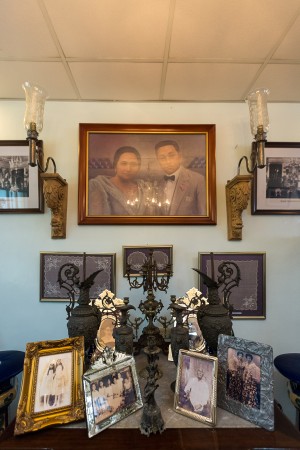
Urban legend
One story that has passed into Apalit urban legend concerns President Marcos who, in the early years of martial law, promulgated austerity measures, including the banning of lavish fiestas.
A bearded figure calling himself Apung Iru of Apalit was said to have appeared out of nowhere to Marcos in Malacañang, berating him for stopping the celebration of “his” feast. He then vanished just as mysteriously.
Not long after, presidential security men appeared in Apalit looking for the intruder named “Apung Iru.” They were pointed to the chapel, where they saw the image of Apung Iru, and were dumbfounded. The image matched the president’s description to a T: sharp nose, white beard, fair skin.
Meanwhile, Gonzalez is attempting to work a miracle of his own in keeping this tradition alive amid the ruins of the family’s ancestral home.
Following the fire, Apung Iru’s chapel was quickly rebuilt by Gonzalez’s uncle, Bro. Andrew Gonzalez, in time for the fiesta of 2003. (Brother Gonzalez was the head of the De La Salle system of schools and was education secretary in the Estrada administration.)
He also directed the construction of an annex, which the family has named Espiritu Hall. It is now the seat of St. Peter’s Mission, Inc., a nonstock, nonprofit company formed for the maintenance of Apung Iru.
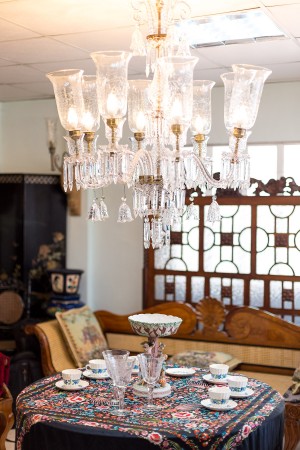
Making peace
Gonzalez writes, “I assumed the responsibility for Saint Peter’s Mission, Inc. when my aunt Dr. Erlinda Arnedo Sazon-Badenhop (Arnedo, first cousin of my dad), camarera/steward of Apung Iru from May 1987, passed away in February 2008. Her mother, Elisa Espiritu Arnedo-Sazon (youngest sister of my Arnedo grandmother), was camarera/steward from May 1977. My grandmother, Rosario Espiritu Arnedo-Gonzalez, was camarera/steward from May 1970.
“From the postwar years until the burning in 2002, all the beautiful contents—furniture and decorations—painstakingly assembled in the early 1900s by the eccentric collector Maria ‘Maruja’ Espiritu y Dungo (Mrs. Macario Arnedo) of the bahay na bato were sold off by various family members to finance basic necessities (although not us). Among the top art and antique collectors of Manila, their Arnedo pieces are among the most beautiful.
“The Espiritu Hall was sparsely furnished when I took over: a big lopsided vinyl top table on iron legs and four Monobloc single chairs. No electric fans, no air-conditioning, no comfort whatsoever.
“In an attempt to ‘make peace’ with the Arnedo-Espiritu family’s troubled past, I decided to assemble my own old furniture and decorations to conjure up the atmosphere of a happier time for their family, the early 1900s when Macario Arnedo and Maria Espiritu were newly married, relatively prosperous and were just creating their family. Before big-stakes gambling, bankruptcy, untimely deaths, insanity/madness, wrong choices, wrong marriages, and impoverishment hit their family.
“The late, great American interior decorator Sister Parish used to say: ‘You don’t really need to go shopping. You make do with what you have.’
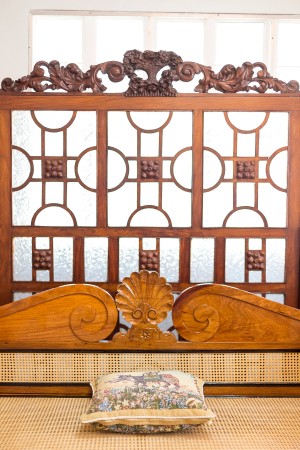
“I have not bought anything specifically for the Espiritu Hall. I simply looked around my place in the city and took whatever I thought would fit my vision of the place, what would look like ‘Macario and Maria Arnedo in the early 1900s.’ It has all worked together very well. Nothing expensive, nothing precious. Nothing pretentious. Just old things with lots of memories.
“Maria Espiritu de Arnedo was an avid plant lover in her time, even employing a Japanese gardener prewar. So today, we work on reviving the garden. Vegetables, fruits and flowers are priorities; the plants and their bounty are shared with the community. Mere ornamentals are low on the totem pole.
“Yes, life at Saint Peter’s chapel compound is ‘tradition lived in present tense.’ But with heads faced resolutely to the future.”















